小脳の解剖学、機能、疾患
The Cerebellum: Neuroanatomy Video Lab – Brain Dissections 2015/09/09 Eccles Health Sciences Library Digital Publishing
The Cerebellum: Neuroanatomy Video Lab – Brain Dissections 2015/09/09 Eccles Health Sciences Library Digital Publishing
Clinical Chemistry – Tumour Markers as Diagnostic Tests for Cancer 2018/12/06 LaboTube Channel
Liver Cancer | Advancements in Treatment Options 2017/06/05 Johns Hopkins Medicine
肝臓がんの治療方法は多様であり、がんの状態に合わせて選択されるそうです。下の動画では、UCLAの放射線医が、インターベンショナルラジオロジー(Interventional Radiology; IVR)による治療として、Thermal ablation(Radiofrequencey Ablation (RFA)経皮的ラジオ波焼灼療法), Microwave Ablation (MWA))、 Transarterial chemoembolization (TACE)、 Transarterial Y90 Radioembolizationの3つの方法を紹介しています。
Minimally Invasive Treatment for Liver Cancer – Sid Padia, MD | UCLAMDCHAT 2017/10/17 UCLA Health
IPILIMUMAB(MDX-010)で臨床試験のデータベースNIH ClinicalTrials.govを検索した結果です(2019年11月3日検索)
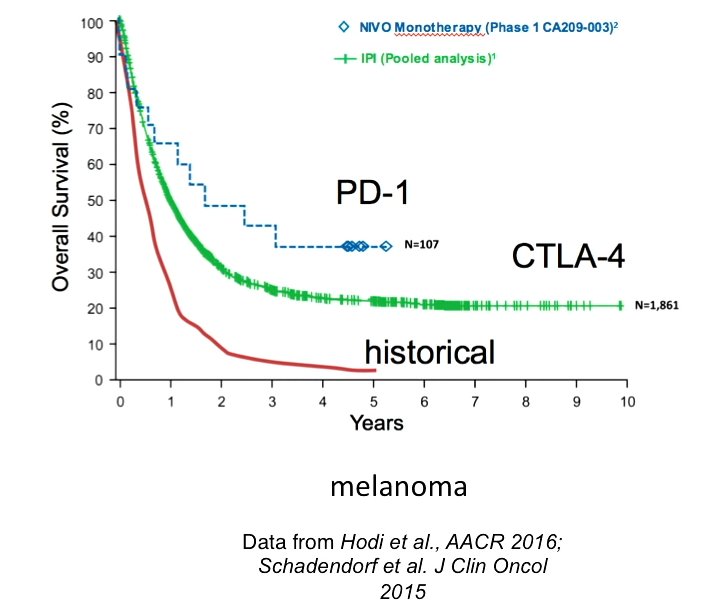
2018年に本庶佑博士とともにノーベル医学生理学賞を受賞したジェームス・アリソン博士が、最初の臨床試験のことを語るインタビュー動画。
2015 Lasker DeBakey Clinical Medical Research Award 2015/09/07 Albert and Mary Lasker Foundation
Talks@12: Immunotherapy: An Answer to Cancer? 2017/11/07 Harvard Medical School
目次
上の動画でも登場したSharon Belvinさんのストーリー。
She’s the Answer to Cancer…and So Are You 2016/05/06 Cancer Research Institute
On 25 March, the FDA cleared ipilimumab, produced by Bristol-Myers Squibb, based in New York, to treat advanced melanoma, a particularly lethal form of skin cancer. Although the drug typically lengthens a patient’s life by only 4 months or so, in clinical trials a fraction of patients lived much longer.
Although ipilimumab can add years of life, only 20–30% of patients show any benefit at all (F. S. Hodi et al. N. Engl. J. Med. 363, 711–723; 2010).
(引用元:Melanoma drug wins US approval. Nature volume 471, page 561 (2011) 28 March 2011)
“Concussion Management” by Michael O’Brien for OPENPediatrics 2018/08/10 OPENPediatrics
Concussions: Heading for Change – an NET Sports Feature 2014/11/12 NETNebraska
SCAT5 – Sport Concussion Assessment Toolの実際。
SCAT5 – Sport Concussion Assessment Tool 2018/07/18 Aspetar
通常のインターネットブラウザでアクセスしているのは、インターネット全体のほんの氷山の一角なのだそうです。水面下にある部分はディープウェブと言われます。ディープウェブの一部に、ダークウェブがあります。
Why You Should Never Visit The Dark Web 2019/01/31 The Infographics Show
Macrolides: Mechanisms of Action and Resistance 2011/03/30 Mechanisms in Medicine
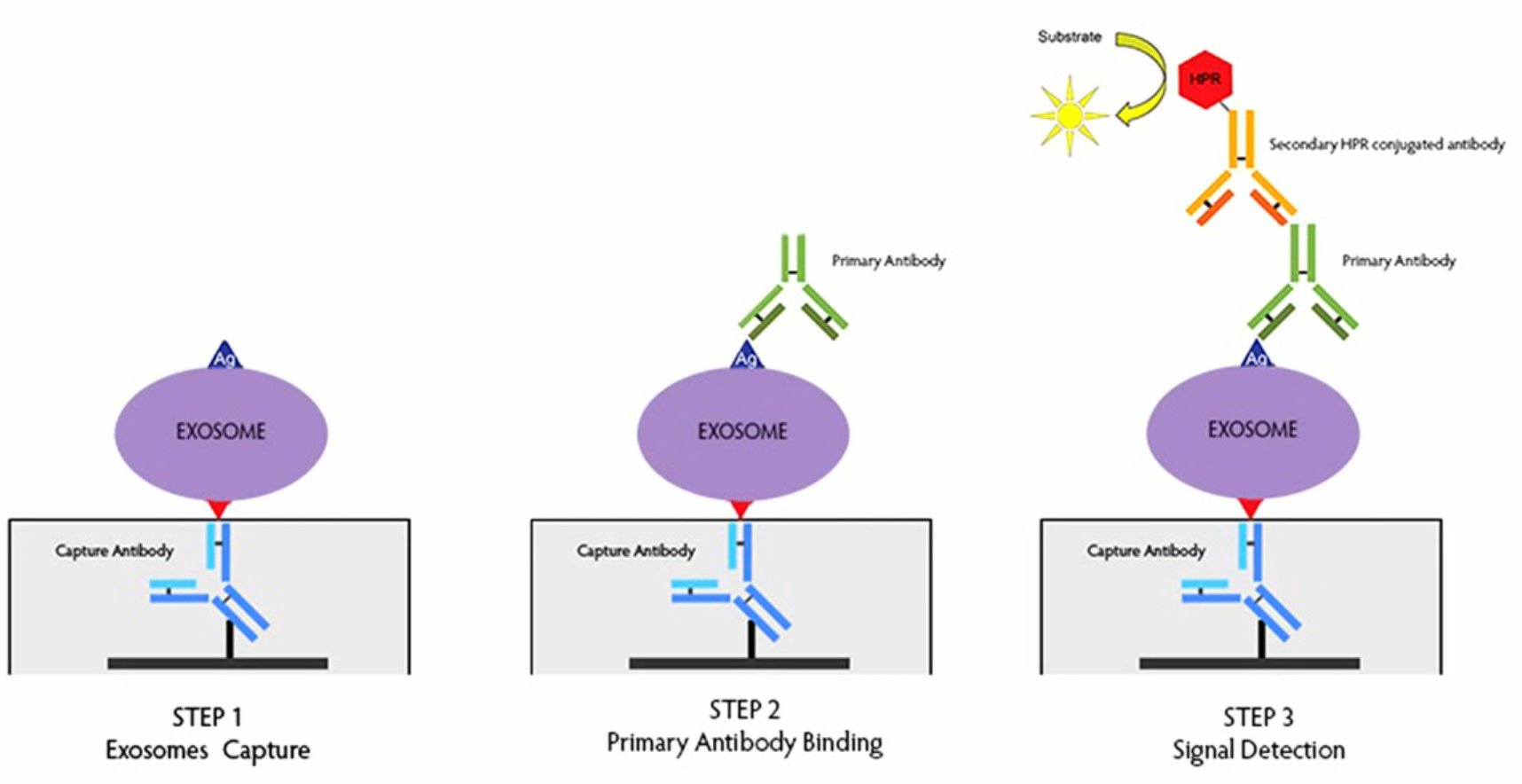
How to use ExoTEST Kit (kit for exosome capture and quantification) 2015/07/25 HansaBioMed Life Sciences Ltd
目次
シェーグレン症候群は1933年にスウェーデンの眼科医ヘンリック・シェーグレンの発表した論文にちなんでその名前がつけられた疾患です。日本では1977年の厚生労働省研究班の研究によって医師の間に広く認識されるようになりました。 本疾患は主として中年女性に好発する涙腺と唾液腺を標的とする臓器特異的自己免疫疾患ですが、全身性の臓器病変を伴う全身性の自己免疫疾患でもあります。シェーグレン症候群は膠原病(関節リウマチ、全身性エリテマトーデス、強皮症、皮膚筋炎、混合性結合組織病) に合併する二次性シェーグレン症候群と、これらの合併のない原発性シェーグレン症候群に分類されます。(指定難病53 難病情報センター)
一部の患者では、口または眼の乾燥だけがみられます。… 多数の臓器が侵される場合もあります。シェーグレン症候群では、鼻、咽頭、消化管、喉頭、気管、気管支、外陰部、腟の表面を覆っている粘膜が乾燥することがあります。(MSDマニュアル家庭版)
Sjögren’s syndrome 2014/02/25 Dr. Andras Fazakas
シェーグレン症候群(SjS)改訂診断基準(厚生労働省研究班、1999 年)
1.生検病理組織検査で次のいずれかの陽性所見を認めること
A)口唇腺組織でリンパ球浸潤が 1/4m ㎡当たり 1focus 以上
B)涙腺組織でリンパ球浸潤が 1/4m ㎡当たり 1focus 以上
2.口腔検査で次のいずれかの陽性所見を認めること
A)唾液腺造影で stage I(直径 1mm 以下の小点状陰影)以上の異常所見
B)唾液分泌量低下(ガムテスト 10 分間で 10mL 以下,またはサクソンテスト 2 分間 2g 以下)があり、かつ唾液腺シンチグラフィーにて機能低下の所見
3.眼科検査で次のいずれかの陽性所見を認めること
A)Schirmer 試験で 5mm/5min 以下で、かつローズベンガルテスト(van Bijsterveld スコア)で陽性
B)Schirmer 試験で 5mm/5min 以下で、かつ蛍光色素(フルオレセイン)試験で陽性
4.血清検査で次のいずれかの陽性所見を認めること
A)抗 SS-A 抗体陽性
B)抗 SS-B 抗体陽性診断 以上1、2、3、4のいずれか2項目が陽性であればシェーグレン症候群と診断する。(転載元)
これらの自己抗体の名前の由来に関しては、下のレビューでわかりやすく解説されています。
Anti-Ro/SSA and anti-La/SSB antibodies were originally described in 1961 as two precipitating antibodies reacting with antigens contained in extracts from salivary and lacrimal glands of patients with SS, termed SjD, and SjT, respectively [9]. SjD antigen was reported to be insensitive to trypsin or heat, while SjT antigen could be destroyed by the same treatment. In 1969, Clark et al. described the presence of antibodies in the sera of patients with SLE that reacted with ribonucleoprotein (RNP) antigens present in extracts of rabbit and human spleen [10]. The authors named the antibody “anti-Ro antibody” after the original patient in whom the antibodies were identified. The same group also found antibodies to another soluble cytoplasmic RNA protein antigen, “La” [11]. At about the same time, Alspaugh and Tan noted the existence of autoantibodies in the sera of many SS patients, which react with antigens termed “SSA” and “SSB,” [12]. SSB antigen was described also as “Ha”, an antigen targeted by sera from patients with SLE and SS [13]. Later, Ro and La were demonstrated to be antigenically identical to SSA and SSB [14]. (Clinical and Developmental Immunology Volume 2012, Article ID 606195, 12 pages http://dx.doi.org/10.1155/2012/606195 Review Article Clinical and Pathological Roles of Ro/SSA Autoantibody System Ryusuke Yoshimi, Atsuhisa Ueda, Keiko Ozato, and Yoshiaki Ishigatsubo 著作権:CC BY 3.0)
抗SS-A/Ro抗体と抗SS-B/La抗体は共に非ヒストン核蛋白抗体のひとつであり,シェーグレン症候群と密接に関連している。しかし,抗SS-A抗体は多くの膠原病で陽性を示す。(抗SS-A/Ro抗体 SRL総合案内)
異常値を示す主な疾患・状態・異常高値:シェーグレン症候群の50~70% 全身性エリテマトーデス(SLE)の40~60% 重複症候群の40~60% 強皮症の10~30% 多発性筋炎/皮膚筋炎の10~20% 関節リウマチの20~30%(抗SS-A/Ro抗体 FALCO臨床検査案内サイト)
抗SS-A抗体はシェーグレン症候群の70~90%と最も高頻度に検出されますが、疾患特異性は高くなく、全身性エリテマトーデス(SLE)や強皮症、混合性結合組織病(MCTD)、関節リウマチなど他の膠原病でも広く陽性となります。RNAと蛋白の複合体に対する自己抗体で、対応抗原は細胞質に多く存在するため抗核抗体陰性でも抗SS-A抗体が検出されることがあります。 一方、抗SS-B抗体はシェーグレン症候群の30~40%に検出され、特異性が高く、抗SS-B抗体陽性の場合、抗SS-A抗体も同時に陽性となります。RNAポリメラーゼIIIの転写産物と複合体を形成する蛋白に対する自己抗体で、対応抗原は核内に存在するため抗核抗体ではSpeckled型陽性を示します。(CRC)
残念ながら根本的にシェーグレン症候群を治癒させることはできません。乾燥症状に対しては症状を軽くすること、他の臓器障害に対してはそれらを抑えることを目的とした治療を行います。(シェーグレン症候群 (Sjögren’s syndrome: SS) しぇーぐれんしょうこうぐん KOMPAS 慶応義塾大学 医療・健康情報サイト)
T医師が漠然と感じているような疑問は、臨床に携わっていると日常的に沸き起こってくるはずです。…
「臨床研究」とは、このような漠然とした疑問を、検証可能な「リサーチクエスチョン」として構造化させ、科学的な手法を用いて解決していく過程です。そして疑問を解決していく中で、また新たなリサーチクエスチョンが生まれて来る。そのような連鎖が、臨床医学を前へと進める推進力であり、臨床研究のだいご味です。(臨床研究者育成プログラムのご紹介 東京大学医学部)
病気を深く知ろうとする行為そのものが研究であると考えれば、よい臨床医になるためには研究という作業が必ず伴うのではなかろうか。(京都大学大学院医学研究科・医学部 皮膚科学 教授エッセイ)
臨床研究の大きな流れとしては、まず「後向き研究」からスタートして糸口をつかみ、「前向き研究」の「観察研究」で方向性を定め、さらに「介入研究(臨床試験)」で確認する、というのが王道ですね。…
こうした疑問点をガイドラインなどで調べても、エビデンスがはっきりしない場合がしばしばあります。こういう時こそ問題解決の一つのチャンスなので、さあ後向き研究をやろう、となるわけです。…
後向き研究をやってみると、何かしら解決すべき問題が出てきて、これを前向きに調べることになります。そこまでやると、自分のテーマとしてこれを突き詰めたくなる。(インタビュー第6回:神山 圭介 教授 「治験」と「臨床研究」の違い 慶応義塾大学病院臨床研究推進センター)*太字強調は当サイト
『臨床研究 英語論文 最速最短』は臨床医に研究を勧めて、実際にアイデアの出し方から論文アクセプトに至るまでの道のりをガイドしてくれる本なのですが、基礎研究しか知らない自分が読んでも非常に面白く、大変役立つ内容でした。自分の研究の一番のブレーキになる上司とのかかわり方であるとか、論文原稿を教授が何か月も放置して読んでくれないときにどうすべきかなど、研究者がしばしば遭遇する困難への対処方法、実践的なアドバイスが満載です。
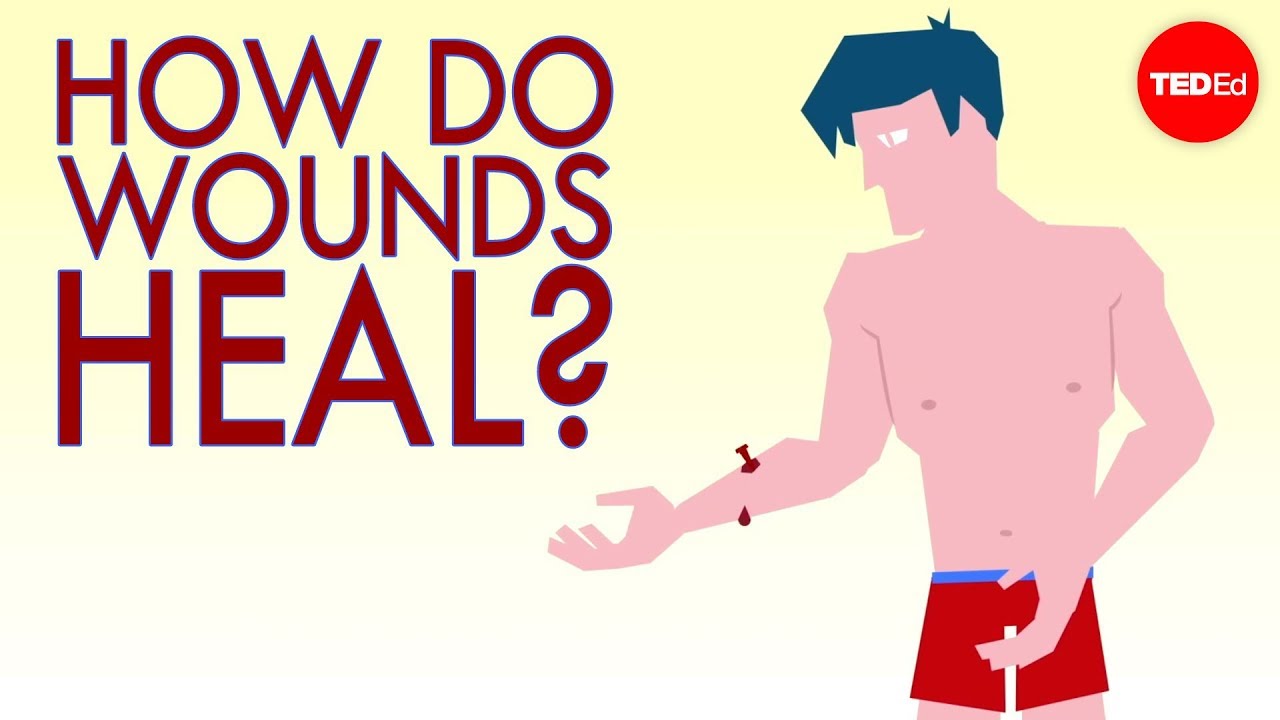
怪我をして皮膚を切ったりしたときに、人間の体はどのようにして傷を修復するのでしょうか?下の動画が非常にわかりやすく説明してくれます。
創傷が治癒する過程
ケガはどのように治るのか? - サルタック・シンハ 2014/11/11 TED-Ed
Stages of Wound Healing Process 2014/09/28 usmlesteps123
傷の修復過程で線維芽細胞(Fibroblasts)が傷のところに集まってきますが、その過程を模倣した実験観察の動画(下)。
Wound Repair and Fibroblast Migration 2016/09/19 Zar
Ventricular Septal Defect (VSD) Surgical Repair – Pediatric Heart Surgery 2008/08/20 Nicklaus Children’s Hospital
ノーベル化学賞の旭化成・吉野彰氏「リチウムイオン電池が受賞してうれしい」(2019年10月9日 THE PAGE ザ・ページ)
吉野彰氏の略歴:
1966年 – 大阪府立北野高等学校卒業
1970年 – 京都大学工学部石油化学科卒業
1972年 – 京都大学大学院工学研究科石油化学専攻修士課程修了
1972年 – 旭化成工業株式会社(現旭化成株式会社)入社
(参照:ウィキペディア)
2018 Japan Prize Commemorative Lecture: Dr. Akira Yoshino 2018/04/23 JapanPrize
Detection and identification of bacteria in clinical samples by 16S rRNA gene sequencing:comparison of two different approaches in clinical practice
https://www.microbiologyresearch.org/docserver/fulltext/jmm/61/4/483_jmm030387.pdf?expires=1570540556&id=id&accname=guest&checksum=5420BE74E3BA950EA45B92F013CBE211
Efficient Nucleic Acid Extraction and 16S rRNA Gene Sequencing for Bacterial Community Characterization
https://www.jove.com/video/53939/efficient-nucleic-acid-extraction-16s-rrna-gene-sequencing-for
Using a 16S rRNA Sequence to Identify a Bacterial Isolate (2017/10/03 Oxford Academic (Oxford University Press))
What Is 16s rRNA sequencing? (2018/08/01 CD Genomics)
https://www.youtube.com/watch?v=3UHiveJ1jzM
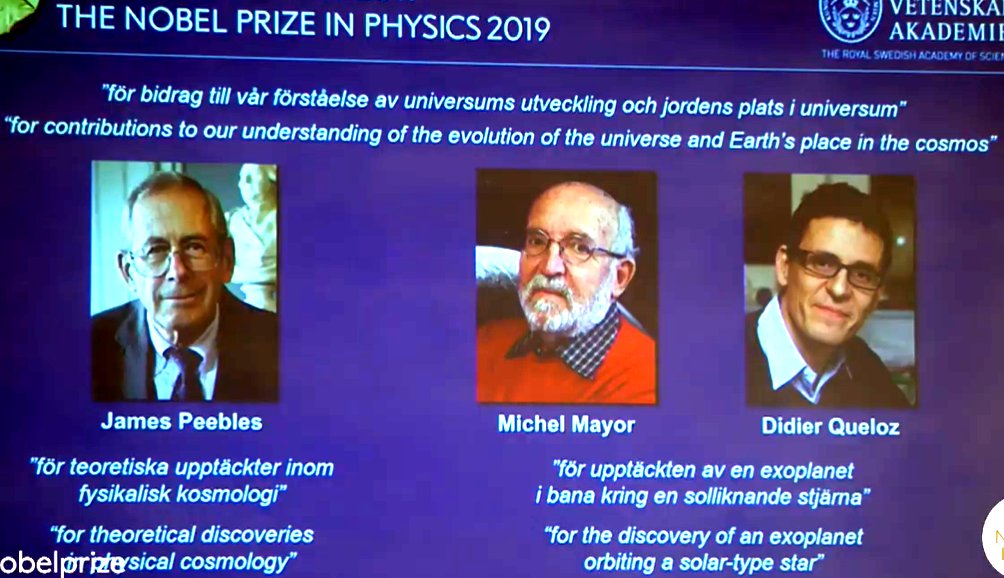
8 October 2019
The Royal Swedish Academy of Sciences has decided to award the Nobel Prize in Physics 2019
“for contributions to our understanding of the evolution of the universe and Earth’s place in the cosmos” with one half
to James Peebles Princeton University, USA
“for theoretical discoveries in physical cosmology” and the other half jointly
to Michel Mayor University of Geneva, Switzerland
and Didier Queloz University of Geneva, Switzerland University of Cambridge, UK
“for the discovery of an exoplanet orbiting a solar-type star” (nobelprize.org)
Announcement of the Nobel Prize in Physics 2019
2019年度ノーベル医学生理学賞は、低酸素刺激に対して生体がどのように反応するかに関する研究を行ったウィリアム・ケリン、ピーター・ラトクリフ、グレッグ・セメンザの3氏に贈られました。
HIF-1は,肝がん細胞株 Hep3B において「低酸素依存的 にエリスロポエチン(EPO)を誘導する因子」として1992 年に Semenza らによって発見された.
Semenza, G.L. & Wang, G.L.(1992)Mol. Cell. Biol., 12, 5447―5454.
エリスロポエチン(Epo)は赤血球産生を制御する造血ホルモンであり、組織の低酸素に応答して産生され、骨髄などの造血細胞に働いて赤血球産生を刺激します(図2)。高地トレーニングをしている運動選手の血液では赤血球数、および、酸素運搬に関わるヘモグロビン量が増加しますが、これも低酸素環境におけるEpo産生の亢進によるものです。また、ヒトの大人ではEpoは主に腎臓において産生されます。(引用元:エリスロポエチン遺伝子の発現制御 dmbc.med.tohoku.ac.jp)
腎臓は酸素消費が多く,更に動静脈シャントのため 酸素の取り込み効率が悪いため,低酸素状態になりや すい臓器であり,様々の要因によって引き起こされる 尿細管間質の慢性低酸素が腎臓病の final common pathway として注目されている。(引用元:日児腎誌 Vol. 25 No. 2)
腎臓は生体が必要とする酸素の30%を消費する,非常に酸素需要の高い臓器となっている.このため,腎臓病のfinal common pathwayとして,尿細管間質の慢性低酸素状態が特に重要と考えられている.(第 113 回日本内科学会講演会 結実する内科学の挑戦~今,そしてこれから~ 平成28年4月17日(日)東京都・東京国際フォーラム 日本内科学会雑誌 105 巻 9 号)
腎が低酸素になりやすい理由としては,エネルギー需要が高いことに加え,尿細管周囲毛細血管網による酸素供給が血行動態の変化により影響を受けやすいことや,解剖学的な理由により動静脈酸素シャントが存在するため酸素の利用効率が悪いことがあげられる.(慢性低酸素状態の腎臓 244巻4号 2013年1月26日 医学のあゆみ)
EPO遺伝子の転写を促進する低酸素誘導因子(hypoxia-inducible factor: HIF)が同定され、さらにその上流の調節機構が解明されたことを背景に、「HIF活性化薬」としてPHD阻害薬が開発されました。 PHDはHIF (α鎖)を水酸化し、ユビキチン・プロテアソーム分解を導く酵素で、PHDの酵素活性を阻害するとHIFは安定化し、HIFを介する低酸素応答が誘導されます。(第4回(1)EPOから生まれた「HIF刺激薬」ここがすごい!執筆:田中哲洋(東京大学医学部附属病院)、監修:南学正臣(東京大学医学部附属病院)2018年8月15日 m3.com)
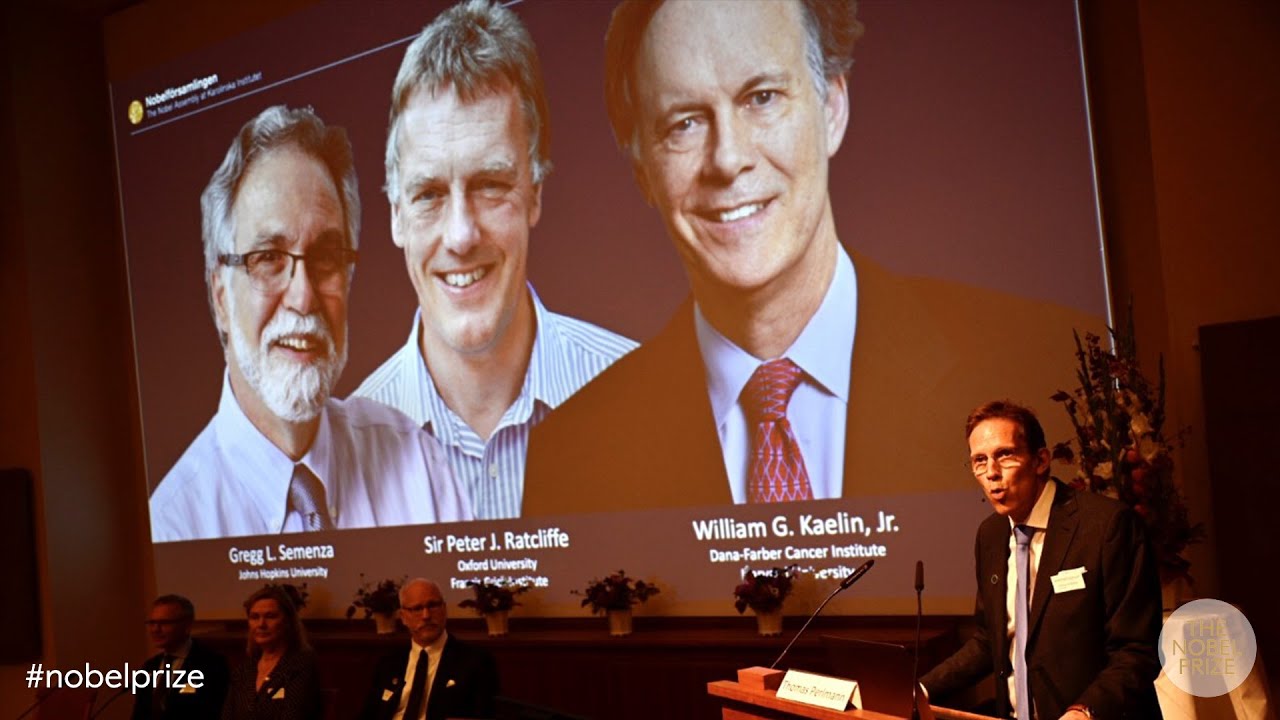
2019年ノーベル医学生理学賞はウィリアム・ケリン、ピーター・ラトクリフ、グレッグ・セメンザの3氏に贈られました。
The Nobel Assembly at Karolinska Institutet
has today decided to award
the 2019 Nobel Prize in Physiology or Medicine
jointly to
William G. Kaelin, Jr., Sir Peter J. Ratcliffe and Gregg L. Semenza.
for their discoveries of how cells sense and adapt to oxygen availability (PDF)
Announcement of the Nobel Prize in Physiology or Medicine 2019 Nobel Prize
ノーベル賞受賞直後のピーター・ラトクリフ氏の電話インタビュー
ピーター・ラトクリフ博士の講演動画。
Elucidation of oxygen sensing pathways in human and animal cells // Peter Ratcliffe 2018/09/28 The Physiological Society
ウィリアム・ケリンのレクチャー動画。
Signaling Pathways in Cancer Symposium: William Kaelin 2016/08/11 KochInstituteMIT
グレッグ・セメンザ(Gregg Semenza)が語る研究者の日常、研究はいかに進むか。
Gregg Semenza on the discovery of HIF-1
下の動画は、生い立ちから研究の話までのロング・インタビュー。
JCI’s Conversations with Giants in Medicine: Gregg Semenza 2016/11/02 Journal of Clinical Investigation
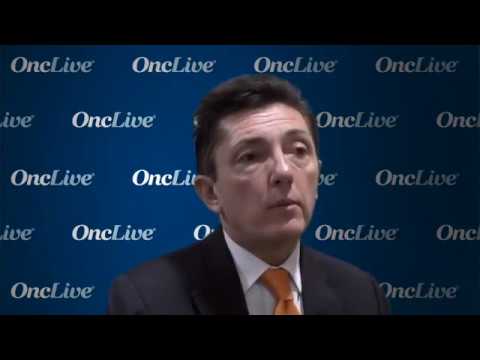
国際標準の治療効果判定規準である RECIST(Response Evaluation Criteria in Solid Tumors)guidelines がその妥当性ならびに従前のWHO 規準との再現性から、2000年に固形がん治療効果判定の国際標準として認知されている。RECIST は 2009 年
に EORTC(European Organization for Research and Treatment of Cancer)より改定された(E.A. Eisenhauer, et al. Eur J Cancer 2009;45:228-47)。(20-15 画像によるがんの診断、治療法選択、治療効果判定に関する研究)
2010年に Lencioni らによって提唱された modified RECIST(mRECIST)は,早期濃染 部の径を測定することで肝癌治療効果判定に血流評価を加えた新しい基準である.(肝臓 53 巻 3 号 147―154(2012))
一般的に固形癌の治療効果判定基準として WHO 基準を簡略化した Response Evaluation Criteria in Solid Tumors version1.1(RECIST1.1)が用いられている.しかしながら,肝細胞癌の治療においては,腫瘍壊死を治療効果として考えることが一般的であり,腫瘍壊死を効果判定基準に考慮されていない RECIST1.1 は問題があるとされている.一方,肝細胞癌の治療効果判定基準として腫瘍壊死を考慮に入れた modified(m)RECISTと日本肝癌研究会による肝癌治療直接効果判定基準 Response Evaluation Criteria in Cancer ofthe Liver(RECICL)も使用されている.mRECISTと RECICL でも 1 方向測定と 2 方向測定で明らかな違いがあり,その実用性,有用性については議論が分かれている.(肝臓 53 巻 6 号 344―347(2012))
Dr. Lencioni on Assessing Response to HCC Therapy 2018/09/16
例えば、薬物投与前後で差があるかどうかを調べるために経時変化を追う実験を行ったとします。どの時刻で開始時刻(薬物投与前)と差が出るかを調べるために、複数のデータポイントの各々と測定開始時とをペアワイズに比較することにして、2群間の比較でよく使うt-検定やWilcoxon検定を単純に適用してよいものでしょうか?たまに、そのような解析をした論文をたまに見かけることがありますが、これは非常に初歩的な、統計の誤用だと思われます。
データを入力するだけで統計ソフトが出力を返してくれるので、適用する検定方法が間違っていたとしても、P値だけは簡単に得ることができてしまいます。その結果、有意差がないデータに有意差を見出して論文報告してしまう危険があるので、要注意です。
鍼灸研究における統計誤用が多発しているため、この経時測定データの解析法について調べても、ほとんど誤用といってよい(経時測定データの解析法 七堂利幸)
多群間の平均値の比較において,その目的に応じた多重比較法を用いることが一般化してきた.しかしながら,経時データのように複数の測定時点がある場合に,時点ごとに多重比較法を繰り返し適用することは,いずれかの時点で有意な差が出やすくなる「時点の多重性の問題」が新たに生じてしまう.(引用元:日薬理誌133,325~331(2009))
比較試験では各被験者について経時的に種々の評価や測定がなされ、経時的な薬効差の検討が行われる。この際の検定に当っては、薬剤群ごとに処置開始時点とそれ以降の評価時点とに対応のある場合の検定を繰返したり、各時点とに2群間での対応のない場合の検定を繰しがちであるが、それでは第1種の過誤の確率の増大する。(引用元:臨床試験の統計解析に関するガイドライン 平成4年3月4日)
一般に用量時間反型データに繁用されている統計解析は2種類ある.一っは「輪切り」検定であり,他の一っは2元配置分散分析である.(薬理試験における統計解析のQ&A 反復測定データの解析法への一提案 吉村功、大森崇 日薬理誌110、333~340(1997))
13.経時的比較
比較試験では各被験者について経時的に種々の評価や測定がなされ、経時的な薬効差の検討が行われる。この際の検定に当っては、薬剤群ごとに処置開始時点とそれ以降の評価時点とに対応のある場合の検定を繰返したり、各時点とに2群間での対応のない場合の検定を繰しがちであるが、それでは第1種の過誤の確率の増大する。このようなデータの場合には時点毎の比較ではなく、トレンドやプロフィルを比較するための特別な手法が必要である。
(引用元:臨床試験の統計解析に関するガイドライン 平成4年3月4日 http://home.att.ne.jp/red/akihiro/Old_stat_guideline_Japanese.pdf)
慢性疾患のための治療の研究で、経時的に機能の状態を評価する場合も、主要変数の選択に関して別の問題が生じる。可能な対処法としては、観察期間の最初と最後になされた評価の比較、全期間を通じたすべての評価から求めた傾きの比較、定めた閾値を超える若しくは下回る被験者の割合の比較、又は繰り返し測定データのための方法に基づいた比較といった多くのものがある。(引用元:2.2.2 主要変数と副次変数 臨床試験のための統計的原則 医薬審 第1047号 平成10年11月30日) *太字強調は当サイト
下は、なんでもかんでも検定して有意差を出せばよいと思っている人に対する警告。
では両者に共通な問題点は何だろうか.それは実験で知りたいことが反応の時間曲線であり,それが用量によってどうわるかであるのに,それに答えられるはずのない「検定という形式」の統計解析を行っていることである.ここで採用している検定という形式は,「反応が用量によって変わらない」あるいは,「反応が時間によって変わらない」という仮説が,実際に測定したデータから否定できるかどうかを判定するものである.だからそれによって得られる結論は,「反応が用量によって変わるところがあるかどうか」,あるいは「反応が時間によって変わるところがあるかどうか」ということでしかない.(薬理試験における統計解析のQ&A 反復測定データの解析法への一提案 吉村功、大森崇 日薬理誌110、333~340(1997))*太字下線強調は当サイト